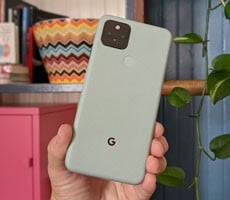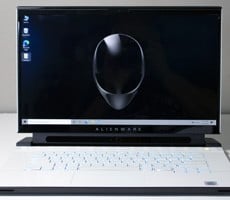Google Pixel 5 Audio, Data, And Call Reception
We used the Pixel 5 mostly on AT&T and T-Mobile’s low-band
5G networks in San Francisco (bands n5/n71 850MHz/600MHz) and
didn’t have any issues with call quality or data speeds. This
phone also supports mid-band 5G (n41, 2.5GHz) on T-Mobile, plus
mmWave 5G on both AT&T and Verizon, but these networks aren’t
deployed in our area. Note that the Pixel 5 Google sells abroad
only supports sub-6GHz 5G.
On the audio front, the Pixel 5 has stereo speakers, but it’s not
what you think. The bottom edge-firing driver handles one channel,
but there’s no earpiece for the other channel. Instead, the
surface of the display is used as a speaker. This works fine for
calls, but sounds tinny with music. While there’s no headphone
jack, the Pixel 5 supports both analog and digital audio devices
over USB Type-C plus aptX HD and LDAC over Bluetooth.
Google Pixel 5 Performance
We’ve now reviewed quite a few
Snapdragon 765G-equipped handsets here at
HotHardware, and our
takeaway is mostly the same each time. For day-to-day apps, this
chip performs well enough to provide a smooth and fluid user experience.
It’s only when doing graphically-demanding tasks -- like hardcore
gaming -- that you notice a difference. Combine this with the
power efficiency of a built-in 5G modem (X52), and this SoC is a
winner for most users.
This begs the question: does a phone still need a flagship
processor to be called a flagship in 2020? Overall, the Snapdragon
765G -- combined with a 90Hz screen, 8GB of LPDDR4X RAM, 128GB of
UFS 2.1 storage, and a clean build of Android 11 -- makes the
Pixel 5 sing. It’s not
OnePlus Nord snappy, but it’s still
pleasantly quick, and -- despite Android 11’s apparent performance degradation --
it juggled our normal set of apps with aplomb.
 |
| Geekbench 5 |
| Synthetic CPU Benchmark |
|
The latest version of Geekbench for Android has aligned its
scores with the desktop version of Geekbench 5. Let's see how
the Pixel 5 fares versus some of its competitors...
In these Geekbench 5 tests, the Pixel 5 finishes in the
bottom of the pack. The
iPhone 11 Pro still has the strongest
single-core performance overall, but the Pixel 5 lags behind other Snapdragon 765G-equipped Android 10 devices. You can get
a good feel for the
Android 11 performance drop by comparing
the Pixel 5 results with the Pixel 4a scores.
 |
| Futuremark PCMark For Android |
| General Purpose
Pocket Computing Performance Metrics |
|
Futuremark's PCMark for Android
is an excellent suite of tests if you want to benchmark a
wide range of tasks on any handset -- things like image and
video editing, as well as lighter-duty, everyday workloads
such as email and web browsing. When you see the test
running live, it's clear the scripted application tests are
carefully selected and tuned to make use of the each mobile
platform in a very controlled way...
In PCMark, the Pixel 5 just beats Google's Snapdragon
845-equipped
Pixel 3 XL flagship from 2018. While the
Snapdragon 765G powering the Pixel 5 clearly doesn't match the
performance of current flagships for the workloads used in
PCMark for Android, these results are still respectable.
 |
| AnTuTu 8 And AITuTu |
| Platform
Benchmarks |
|
AnTuTu’s latest benchmark
returns a number of metrics ranked with somewhat
nebulous scores, rather than frame rates or time to
complete. Here we're running the latest version of
AnTuTu across an multiple Android devices. AnTuTu
returns four top level performance results which are all
included here: CPU, RAM, 3D, UX (or User Experience),
along with a total score...

We saw more of the same in
the AnTuTu benchmark. Here, the Pixel 5 comes in right
between the Snapdragon 730G-equipped
Pixel 4a and the
Snapdragon 765G-equipped OnePlus Nord.
AITuTu evaluates the AI performance of a device by
leveraging two mainstream neural network models for
machine learning and
AI --
Inception v3 for Image
Classification and
MobileNet-SSD for Object Detection.
The benchmark determines the device’s accuracy and speed
when inferring data from each workload...
Google clearly hasn't done a the best job optimizing AI
workloads on the Snapdragon 765G and Pixel 5. In AiTuTu, the Pixel 5
scores just slightly more than half what the Snapdragon
765G-equipped OnePlus Nord scores.
 |
| 3D Graphics Benchmarks: 3DMark And GFX
Bench |
| Pushing The Pixels |
|
Next we're checking how the
Google Pixel 5 compares in GFXBench, which has been one of
the standard mobile graphics/gaming performance benchmarks
for years. To ensure that display refresh (v-sync) and
resolution aren't limiting factors, we're comparing
off-screen test results here. GFXBench tests OpenGL ES
graphics workloads and we're specifically testing OpenGL ES
3.0 and 2.0...


Graphics performance clearly
isn't the Snapdragon 765G's strongest suit. Here, the Google
Pixel 5's scores are consistently less than quarter of
current Snapdragon 865-equipped flagships, and even significantly behind the Snapdragon 765G-equipped OnePlus
Nord -- likely a result of the Android 11 performance drop and perhaps some driver / framework optimizations still necessary to wring maximum performance from the SoC.
Futuremark's 3DMark Sling Shot is a newer benchmark module
that's been added to the
3DMark
mobile suite. Unlike previous gen 3DMark mobile tests, Sling
Shot is a much more advanced OpenGL ES 3.1 and Metal
API-based benchmark that employs more advanced rendering
techniques, like volumetric lighting, particle illumination,
multiple render targets, instanced rendering, uniform
buffers and transform feedback.

Futuremark 3DMark Sling Shot Extreme Benchmark
We're running this test in off-screen mode once again to
remove display resolution differences from the equation.
This lets us compare cross-platform results more
reliably...
The Google Pixel 5 also
performed worse than current flagships in these 3DMark
tests. It scored about 3/4 of what the Snapdragon
765G-equipped OnePlus Nord scored, but still almost 3x better
than the Snapdragon 665- and 675-equipped
TCL 10-series.
Google Pixel 5 Other Features And Battery Life
Specs are familiar, too. On the radio
front, you’ll find mmWave and sub-6GHz 5G, CAT 18 LTE,
WiFi 5 (802.11ac, 2x2 MIMO), Bluetooth 5.1 (with LE), NFC,
and A-GPS/ GLONASS / Galileo / QZSS positioning. The Pixel
5 also includes an eSIM and the usual array of sensors,
but lacks micro SD support. Also gone is the Active Edge
pressure sensor found on past Pixel flagships, along with
the Pixel Neural Core, making photos slower to process.
The capacitive fingerprint sensor is fast and reliable,
but its placement in the back feels a bit dated. We’d have
preferred a scanner embedded in the power/lock key, for a
cleaner, more modern look. Unlike many competing phones,
there’s also no face unlock of any kind -- not even a
basic 2D implementation without support for mobile
payments. Haptics live up to Google’s usual high
standards, though.

Battery life is surprisingly decent. The 4080mAh battery kept
the Pixel 5 ticking for 13 hours and 39 minutes in our PCMark
test -- at 90Hz no less. As such, you can expect the battery
to last a busy day on a charge. Topping off is reasonably
quick thanks to 18W wired fast charging (USB PD), and there’s
an 18W charger supplied in the box. Alternatively, there’s
also Qi-compatible wireless charging, plus reverse wireless
charging.
Next up: the software, pricing, and our review verdict...






